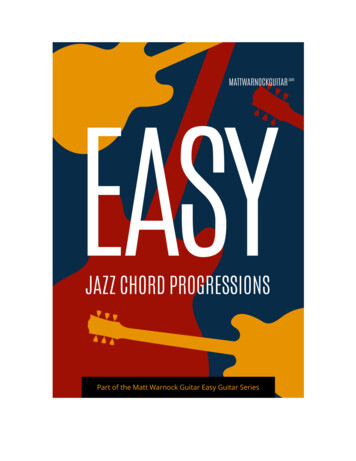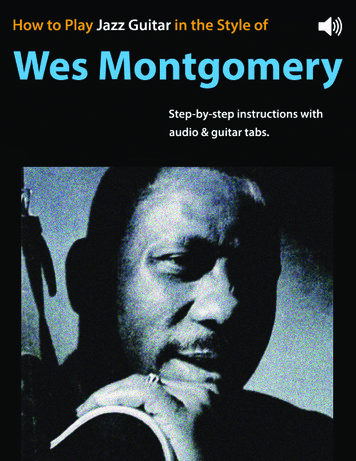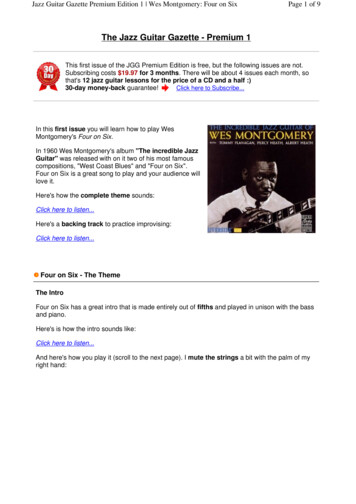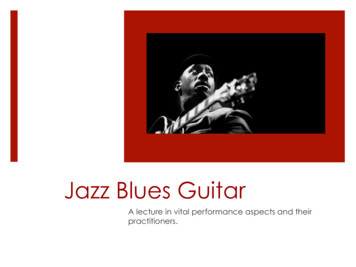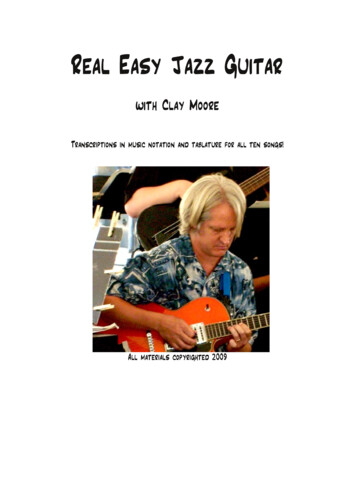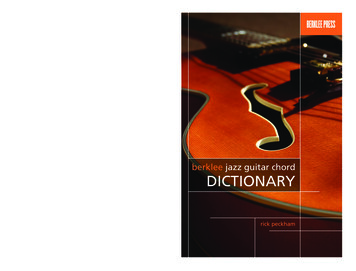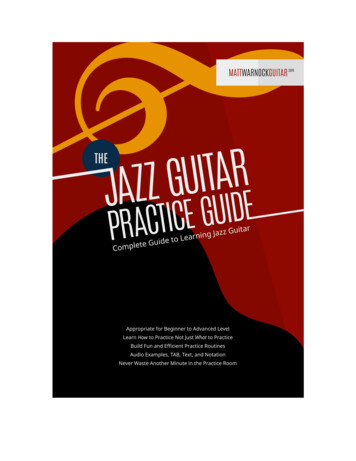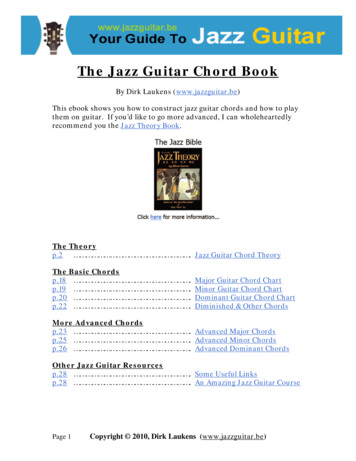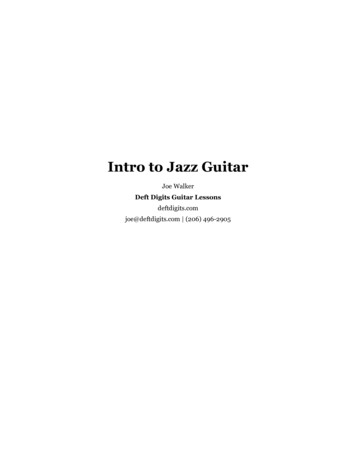
Transcription
Intro to Jazz GuitarJoe WalkerDeft Digits Guitar Lessonsdeftdigits.comjoe@deftdigits.com (206) 496-2905
1. Listen to JazzAs a jazz guitarist, try to think of yourself as a jazz musician first, guitarist second. Throughout the historyof jazz, players of every instrument have learned from each other, copied each other’s licks and ideas, andcomposed for each other. As you begin studying jazz guitar, the best thing you can do for yourself is to listen tojazz, everything you can get your ears on. Below are a few suggestions.The Greats Louis Armstrong - trumpet, vocalsDuke Ellington - piano, bandleaderCharlie Parker - alto saxMiles Davis - trumpetJohn Coltrane - tenor, soprano saxGuitarists Django ReinhardtCharlie ChristianWes MontgomeryJim HallJohn ScofieldPat MethenyAlbums Kind of Blue - Miles DavisSomethin' Else - Cannonball AdderleySaxophone Colossus - Sonny RollinsMoanin' - Art Blakey & the Jazz MessengersGiant Steps - John ColtraneBrilliant Corners - Thelonious MonkBlue Train - John ColtraneThe Savoy & Dial Studio Sessions - CharlieParkerIncredible Jazz Guitar - Wes MontgomeryIn a Silent Way - Miles DavisIdle Moments - Grant GreenBright Size Life - Pat MethenyVirtuoso - Joe PassStandardsJazz standards are really well-known tunes. Kind of like Christmas carols, if you get a group of jazz musicianstogether, they could probably perform a number of standards on the spot, without rehearsal. This is whathappens at jazz jams. There are hundreds of jazz standards, and as you get to know them, in your head andyour hands, you’ll be more aware of the jazz tradition and better able to play with others.I keep track of which tunes get called at jam sessions I attend. Each of the following standards has been calledat least four times. Corcovado (Quiet Nights of Quiet Stars)On Green Dolphin StreetWaveAutumn LeavesStella by StarlightHow High the MoonNight and DayAll the Things You AreNardisAlone TogetherBody and SoulInsensatez (How Insensitive) Freddie FreeloaderStraight No ChaserSolarStolen MomentsBlue BossaA Night in TunisiaBlue MonkThere Will Never Be Another YouCaravanManha de Carnaval (Black Orpheus)SummertimeResourcesListening to the volume of music I’ve suggested above will probably take several years. Don’t worry. Focus onenjoying each new discovery. To find all this music without spending a fortune, I recommend the followinglistening and info resources. Free Music: YouTube, GroovesharkSubscription Music: Rhapsody, Spotifyjazzstandards.com - the 1000 most popular standardsjazz100.sffjazz.com - lists and reviews of jazz albums
2. The EssentialsI don’t like rules. These are not rules. These are my top pieces of advice for guitar students of all ages and skilllevels. I use these strategies relentlessly in my own playing.Use a TunerKeep your guitar as close to perfect tuning as you can. Practice tuning by ear once you know how, but it’simportant to condition your ears to hearing yourself play properly in tune. Professionals with professional earsuse tuners. Buy one and use it every time you play. The easiest way to sound bad is to play out of tune.Use a MetronomeIt keeps you honest. It helps you get faster. It helps you track your progress. It prepares you to play with othermusicians. The second easiest way to sound bad is to play with poor timing.Slow Down, RelaxThis will cure all your frustrations. Any trouble mastering anything on this instrument can be overcome byreducing the tempo and/or releasing your tension.Listen to EverythingSeek out new music, old music, obscure music, anything with which you are unfamiliar. Listen to a widervariety of music than what you can or aspire to play. Listen to your tone, listen to the sounds around you.Play Every DayAt the very least, touch your guitar every single day. Set a bare minimum for yourself (10 minutes, 2 hours,anything) and stick to it.Take Responsibility, Take CreditTake your progress into your own hands. Most of your learning will be done with no teachers around. Andwhere you take responsibility, you can also take credit, so be proud.Play with Other MusiciansMusically connecting with other people is among the most satisfying payoffs for your practice efforts. Don’twait until you think you’re good enough. At a minimum, find someone with whom you can make some noise.3. Know Every Major ScaleOnce you’re in the habit of listening to the great artists and albums of jazz, your next major task is to learn alltwelve major scales. The major scale is so important because all of the music theory that has developed forcenturies in the Western world revolves around it. Every scale, chord, arpeggio, etc. is defined by how it relatesto the major scale. Not only is it useful for every bit of music theory you’ll ever do, but it helps you perform themusic better. All the melodies from the standards listed above are somehow based on major scales. And youcan improvise over 90% of their chord changes with only major scales.Let’s start with C major. Repeat the following exercise until you can effortlessly recite every note in thisposition.
Notice how all the notes in the C major scale above can be played inside three frets plus the open strings. Thereare four other positions, which we’ll see shortly, like this one that allow you to keep your hand in one placewhile your fingers jump between the strings.Structure of the Major ScaleBefore jumping into all 12 major scales all over the fretboard, let’s inspect its structure. Sticking with the Cmajor scale, as it has no sharps or flats, its notes are C D E F G A B C. These are all the white keys on a piano.(The black keys are all sharps and flats.) As it relates to guitar, there are two frets between every C and D. Thatis, there’s always one note between them, higher than C and lower than D, known as either C# (“C sharp”) orDb (“D flat”). This distance of two frets is called a whole step. In the C major scale, there are whole steps fromC to D, D to E, F to G, and G to A. The remaining gaps, E to F and B to C, are half steps, a distance of one fret.Every E on the guitar has an F one fret above it, and every B has a C one fret above it.Take a look at the entire scale again, whole steps indicated between notes:Now you can apply this little formula, W W H W W W H, to any root note. We just did C. If you were to use Eas the root, the second note would have to be F#, because you need a whole step, and E to F is only a half step.(This gets really easy if you’ve taken some time to memorize every note on the fretboard.)All 12 Major ScalesNo need to memorize all of these just yet, but here are all 12 major scales for reference:
Five C Major Scale ShapesReturning to C major, we’ll look at the five different shapes for playing the scale all over the fretboard. Rootsare circled.Work these shapes under your fingers. Run up and down each one until they flow out naturally. Don’t worry ifit takes a while; it’s supposed to. Keep track of the roots.The next step is to branch out to other major scales. Find these same five shapes for Db. Each one will be onefret higher. (You can also move the last shape down to the first fret.) Match up your root notes, Db in this case,with the circled notes in the scale shapes above. Then move to D, then move to Eb, etc., until you’ve found all 12major scales, each one in five different positions.Once you know how to find all these scale shapes, it’s time to learn them like the back of your hand. Drillyourself with different roots and different areas of the fretboard. (Try out the flash card tool on my website:deftdigits.com/flash-cards.)
4. The Easiest Intro to Music TheoryThe major scale is the root of all music theory. Know it well, and the rest of music theory will become easierthan you thought possible. Everything else relates back to the major scale, so it’s crucial to be familiar with itsstructure and scale degrees in order to unravel the rest of this voodoo.Scale DegreesThe important thing to memorize is the structure of the major scale. Say it again! “Whole, whole, half, whole,whole, whole, half!” Now for the fun part.Let’s take the F major and assign numbers to each of the notes:These are called scale degrees. When F is the root, G is the 2, A is the 3, and so on. (The 8 is usually left out,as it’s just the root repeated. But now you can guess why it’s called an octave.) Applying the W W H W W W Hframework to scale degrees, we see that 3 to 4 and 7 to 8 are half steps while all the others are whole steps.Let’s not forget those in-between notes. Just as you can apply sharps and flats to note names to nudge them upor down by a half step, so too can you manipulate scale degrees. As with notes on a musical staff, the sharp orflat occurs before the scale degree. Ab is the b3 of F. B is the #4 of F.Here are all twelve chromatic notes, using F as the root:Give this treatment to any root note, maintaining the same structure, and you can relate all eleven other notesto the root through scale degrees. Remember, it all relates back to the major scale, because that defines theunaltered scale degrees 1 2 3 4 5 6 7.Making SenseFrom this starting point, you can now make a bit of sense of everything else in music theory. Have a fewcurveballs: major chords use scale degrees 1 3 5minor chord: 1 b3 5dominant 7th chord: 1 3 5 b7minor scale: 1 2 b3 4 5 b6 b7Super Locrian scale: 1 b2 b3 3 b5 b6 b7
Even if you don’t know any of the above terms (“Super Locrian?”), you can put the pieces together byapplying the given scale degrees to any root note. If you’re after C Super Locrian, start with the C major scale,and apply the formula:Start with the major scale, and you can always figure out what the notes are in any chord, scale, or melodywhen given the scale degrees.Building Chords from Scale DegreesThe next step is to build chords from these scale degrees. We use Arabic numerals (normal numbers) forindividual notes like scale degrees, but we use Roman numerals for chords. For once, the music theory godsmade it easy for us: a chord is built on the scale degree number represented by its Roman numeral. I is a chordbuilt on scale degree 1. IV is a chord built on scale degree 4.Uppercase is a major chord, while lowercase is a minor chord. ii is a minor chord built on scale degree 2. V is amajor chord built on scale degree 5.You can alter chords the same way you alter scale degrees. bIII is a major chord built on b3. bvii is a minorchord built on b7.If C is the root, and you want to play a chord progression that goes i bVI bIII bVII, you’d play Cm Ab Eb Bb.(This particular progression is used all over the place: Sarah McLachlan’s “Building a Mystery”, SmashingPumpkins’ “Bullet with Butterfly Wings”, Bruno Mars’s “Grenade”, Bravery’s “Honest Mistake”, ArcadeFire’s “Rebellion (Lies)”, The Offspring’s “Self Esteem”.)Apply It!Now you’re off to the races. If you can handle the little bit of theory above, you can handle just abouteverything. It doesn’t get any more complicated than this until you dive into jazz theory or classical analysis.You can now play hundreds of songs just by knowing the Roman numerals for the chords. And you cantranslate a melody or scale from any root note to any other root note by simply using scale degrees.Just remember, the only things you need to know are:1. Where’s the 1? What’s the root of the scale, or the tonic of the key? If a song is in the key of D major or Dminor, use D as 1.2. What’s the structure? W W H W W W H will always give you scale degrees 1 2 3 4 5 6 7. Extract the onesyou need and tweak them as necessary. The more you use this method, the easier it gets. It might take abit of sleuthing at first, putting all the major scale intervals together, but it will become second nature ifyou continue using it.
Incredible Jazz Guitar - Wes Montgomery In a Silent Way - Miles Davis Idle Moments - Grant Green Bright Size Life - Pat Metheny Virtuoso - Joe Pass Standards Jazz standards are really well-known tunes. Kind of like Christmas carols, if you get a group of jazz musicians
